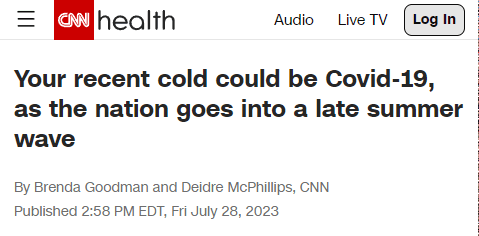Is CNN the new fearmonger in town? Their recent article on a potential COVID-19 summer surge stokes fear and uncertainty among the public, seemingly to the benefit of Big Pharma sponsors. With questionable data interpretation, CNN’s stance appears more an act of manipulation than factual reporting.


The problem begins with CNN’s fear-driven reporting. By focusing on the potentiality of another surge, it manipulates viewers’ perceptions of the situation, paving the way for increased fear, panic, and demand for pharmaceutical products. While the article admits that experts do not expect severe cases or prolonged upticks, this important fact is somewhat glossed over by the surrounding alarmist language.
F**k you
— Dr Jordan B Peterson (@jordanbpeterson) July 29, 2023
Seriously
Never never again
You bloody pathetic fear-mongering
Pharma-fascist shills
The faster you disappear @CNN the better https://t.co/l1FJW3bJlL
CNN cites the Centers for Disease Control and Prevention, noting a rise in hospital admissions, emergency department visits, and test positivity. But it fails to provide context or comparison data, leaving readers to draw the worst conclusions. To an analytical eye, this appears a deliberate attempt to generate fear and prompt viewers to act – potentially in favor of pharmaceutical interests.
Furthermore, CNN quotes an associate director from Helix, a gene sequencing company assisting the CDC. The stated 30%-40% increase in cases since June appears frightening, but when we understand that cases were at a low level, the rise might not be as dramatic as implied. This instance of data manipulation does nothing but stir unnecessary panic.
Interestingly, the media giant admits that laboratory testing and data collection have scaled back since the US ended its public health emergency in May. Despite this, they seem eager to keep the COVID-19 narrative alive. The rationality behind CNN’s insistence on promoting a fear-laden outlook, despite the existence of more encouraging data, invites suspicion about their motives.
In the article, CNN also quotes a Johns Hopkins Bloomberg School of Public Health assistant professor who speculates about another wave. While her caution is understandable, the language used to present this information lacks the balance necessary for objective reporting. Instead, CNN appears more invested in amplifying fear rather than presenting an unbiased view of the situation.
Another point of concern is the data from Biobot Analytics. CNN quickly jumps on the ‘slow-growing’ trend to suggest a potential surge. This claim lacks credibility when considered in light of Biobot’s own assertion that the current concentration of virus particles in sewage samples is about a third of what it was last year.
Moreover, the media outlet uses the threat of other circulating viruses and the human behavior factor to further fuel the fear narrative. This kind of reporting not only affects the psychological well-being of the public but also steers the narrative in favor of pharmaceutical companies who stand to benefit from a fear-driven surge in demand for their products.
Lastly, the article pushes for the use of a bivalent booster and even suggests waiting for a new booster targeting the XBB variant due in September. Once again, the report plays into the hands of Big Pharma by promoting the sales of new vaccines.
CNN’s style of reporting seems to have caused significant damage to its reputation and trustworthiness. This is evident in the falling viewership numbers. Viewers increasingly turn to outlets like “The Next News Network” for truth-based reporting, which signals a decline in public trust in CNN’s fear-driven narratives.
CNN’s COVID reporting, marked by questionable interpretation of data and an apparent bias towards fostering fear, raises valid concerns about its credibility. Viewers and readers deserve balanced and factual reporting, not fear-fueled narratives that seem to serve the interests of Big Pharma sponsors. As public trust in CNN wanes, the responsibility of truthful reporting falls upon alternative news outlets, a task they seem to be embracing wholeheartedly.



